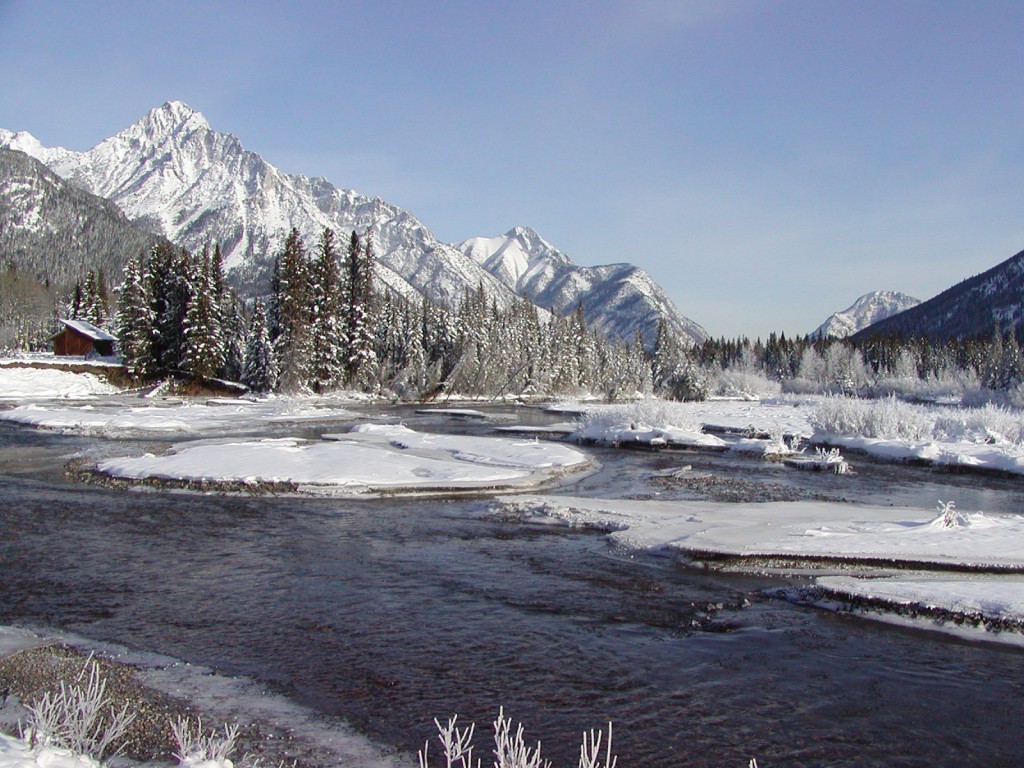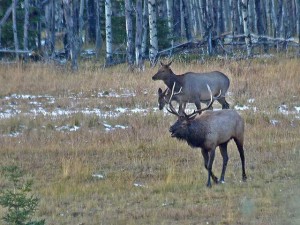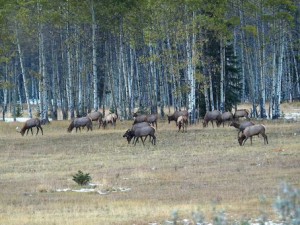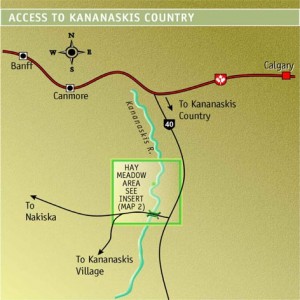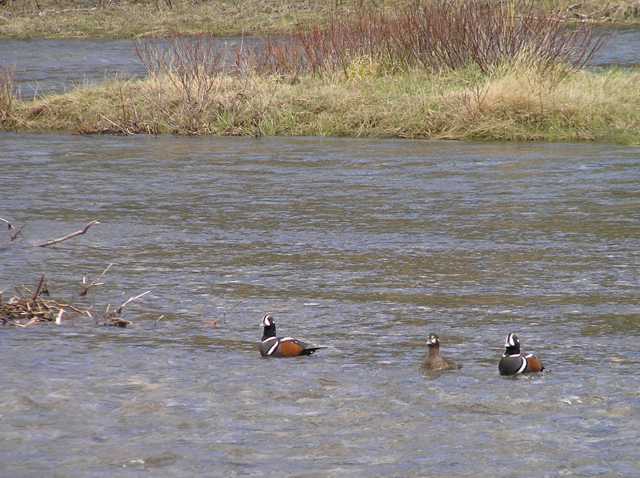Kananaskis Observation Sites
About Kananaskis Country
The explorer John Palliser may have named the area after Kin-e-ah-kis, a native who had survived a skirmish near where the Kananaskis River flows into the Bow. His name can be translated from the Cree as “One who is grateful”. However, many think Kananaskis means “Meeting of the waters”.
Kananaskis Country is preserved by the Alberta Government, and is primarily an un-spoild wilderness area covering over 4000 square km (1440 sq. miles).
Our observation sites in Kananaskis Country are located in valleys, and all are within easy and short walking distances of good parking with very good road access. Our main site is at Hay Meadows, Mt. Lorette Site. Under some conditions we watch from subsidiary sites. These are Wasootch Creek and Lusk Creek.
The Hay Meadows, Mt. Lorette Site
This site is on the bank of the Kananaskis River in a broad open valley which allows excellent viewing of the Fisher Range to the east. The bulk of the Golden Eagles and other raptors use this ridge as part of their preferred migration route.
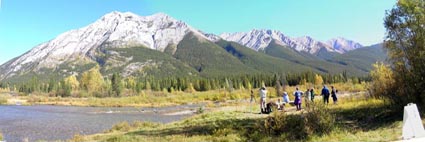
Northwest end of Fisher Range // Southeast end of Fisher Range
Mt. Patrick // Mt. McDougall from Hay Meadow Site – October
CR Cliff Hansen
Naming the various features along the ridge helps us to communicate to each other where eagles are. The peak at the extreme right is Mt. McDougall (2700 m, 8859 ft) about 7.5 km away. We call the nearest mountain “Patrick”, but scramblers call it Wasootch. The big dip at the top of this mountain we call “The Smile” and the little dip to its left “The Little Smile”. Patrick was a young visitor from England who happened to have a magnificent smile. The continuous ridge is broken to the left of “Patrick” where the Kananaskis River flows through. The ridge resumes in Mt Lorette to the northwest- see photo below. To gain height for passage between “Patrick” and Lorette, eagles frequently soar over these peaks.
The lower slope of “Patrick” is seen on the right with the distant hump of Old Baldy above the trees to the right of the Kananaskis River valley. The mountain immediately left of the valley doesn’t have an official name but we call it “The Slab”. The prominent peak to the left is Mt. Lorette. It is almost due north of the observation site. During fall migration Golden Eagles and other raptors appear over Lorette and tend to soar there to gain height for the crossing of the river valley where fewer buoyant up-drafts exist. They often arrive at Patrick rather low and must soar again. The soaring is of great importance since as the birds turn they can show identification features. For example, they may show the upper surface of their tails while soaring, and a snow white tail base identifies a first year Golden Eagle. In the spring, of course, the flow is reversed with the Golden Eagles appearing over McDougall, flying the Fisher Range and soaring at “Patrick” for the crossing to Lorette. Our life would be simple if they all followed this plan. Most do, but Golden Eagles may be seen as little fast moving dots anywhere in the sky. We welcome help!
We find it very necessary to have names for easily recognized features along the sky line.
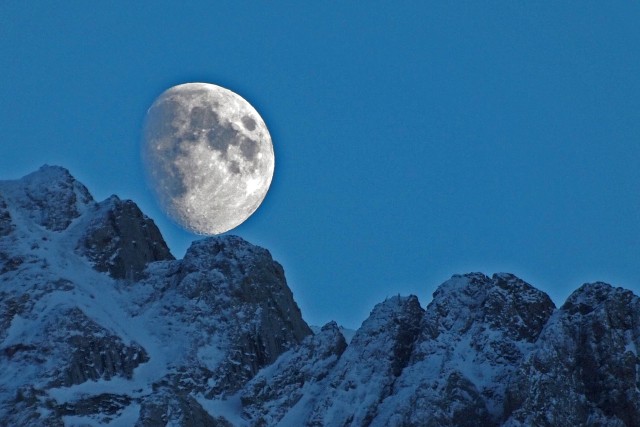
Moon rise over the “Bumps”, Fisher Range.
CR Cliff Hansen
If someone says “There’s one over the Bumps” we all know where to look.
To the west, the open area known as Hay Meadows, allows excellent viewing of Mt. Kidd, Mt. Allan, Mt. Collembola, Skogan Pass, and Hummingbird Plume (We cannot find the origin of that lovely name. – Does anyone know?). Migrating raptors often use these peaks for their route, especially in the spring.
Hidden by the aspens on the left is Mt. Kidd (2958 m), blue in the distance Mt. Bogart (3185m – 10500 feet), the lower slopes of Mt. Allan with the ski slopes of Nakiska occupy the centre of the view, the peak of Mt. Allan (2819m), here looking very small, is just to the left of the small cloud which is sitting above the saddle joining Allan to Collembola on the right. At the extreme right the land is sweeping up to form the low forested ridge of Hummingbird Plume.
The meadow is very beautiful and attracts a variety of grazing wildlife and those that prey on them. The whole area abounds in wildlife and sightings of White-tailed Deer, Mule Deer, Elk, Moose, Bighorn Sheep, Mountain Goat and Coyote are common. Less frequent are Black Bear, Grizzly Bear, Wolf and Lynx. We frequently see tracks of Cougar (Mountain Lion) in the snow, but this animal is very secretive and illusive.
Finding the Hay Meadows, Mount Lorette Site
Turn south from the Trans Canada Highway # 1 onto Highway # 40 and after about 25 km turn right at the sign for Kananaskis Village and the Nakiska Ski Resort. Drive west 1 km. Pass the turn for Kananaskis Village on your left and almost immediately turn right into a paved parking lot signposted Stoney Trailhead. Leave your vehicle there. The UTM coordinates Northing: 5645240, Easting 630842, Zone 11U. The GPS coordinates are DMM:50 56.635 N, 115 8.252 W.
There are two ways to the site. You can follow the gravel road to the north and just after it straightens out after swinging west to avoid a wet area, fork right. The road crosses Hay Meadow to two wooden huts (pump houses for the ski resort) beside the Kananaskis River. The viewing area is a short distance south of these huts. For a prettier, slightly shorter route you can take the trail across the parking lot from the restrooms and walk the well maintained Hiking/Ski trail until you reach the site. The walk to the site is about 1km and involves no elevation rise.
There are restrooms at the parking lot, but not at the count site!
Observation Disclaimer
The Rocky Mountain Eagle Research Foundation (RMERF ) will not accept any responsibility for injury or loss sustained by participants (for any perceived reason including negligence) in any field activities or other functions organized by or for RMERF
On occasion we have been forced by heavy snow or closure of the Hay Meadow trail to use alternate sites, such as the parking lots at the Nakiska Ski Hill, the bridge over the Kananaskis River, or the Mt Allan viewpoint.
Unfortunately, to the east of the Fisher Range are two parallel mountain ridges and beyond them further parallel foothill ridges. We know that weather often forces eagles to abandon their preferred route along the Fisher Range and fly a parallel route.
On occasional days when the mountain ridges are obscured the Principal Observer will decide to move to Wasootch Creek or the little used Lusk Creek Site. This latter site offers fairly open views of the easternmost mountain ridge and the first of the foothill ridges. The site lies about one kilometre east on a secondary road (signed to Calgary) which branches off Highway 40 a short distance north of Barrier Lake. These are a different flyways and eagles counted here are not included in the totals for Mt Lorette.
All of the Hay Meadow, Wasootch Creek, and Lusk Creek sites are kept in mind for future complete recording of Golden Eagle migration when sufficient man power is available.
All the Principal Observers and most of the assistants are well versed in bird recognition. Study of the Golden Eagle migration has brought many thousands of hours of bird expert time to this spot. Within 2 or 3 kilometres of Hay Meadow 236 bird species have been recorded. Scanning for raptors high above the peaks has revealed many other (sometimes unexpected) migrating species. Other birds recorded are beyond their previously known occurrence range. Peter Sherrington deserves special mention for his work in all seasons of many years and in the compilation of extensive information on the birds in the area around Hay Meadow.
A checklist of the birds in Kananaskis Country may be found by accessing the link below.
Kananaskis Birds Checklist. (PDF)
If you are a visitor to Kananaskis you will probably be interested in where you can find suitable accommodation and other exciting places to visit.
Visitor Information and Attractions for Kananaskis area.
On good viewing days during peak migration, visitors to Hay Meadows will find our observers present. You are very welcome to join them. If you need further information please Contact us.

